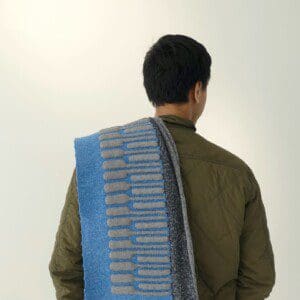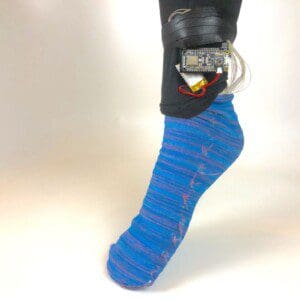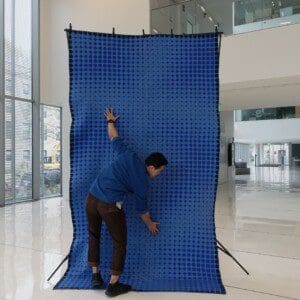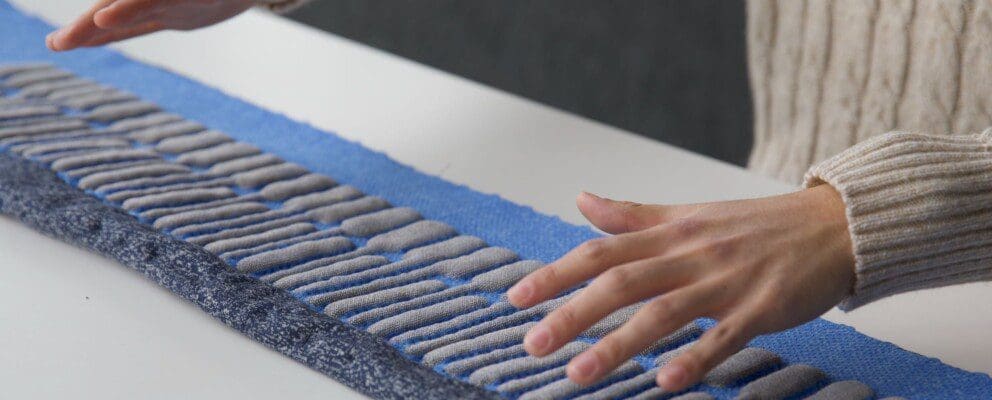
Wicaksono with KnittedKeyboard II. Photo: media.mit.edu
Irmandy Wicaksono is a Ph.D. candidate at the Massachusetts Institute of Technology, pursuing a career in transdisciplinary engineering. One of his specialties is “soft electronics” – from biomedical suits to knitted instruments, these creations integrate the world of fiber and electricity in a way that revolutionizes both.
Take the KnittedKeyboard II, a fabric keyboard that senses your touch and responds musically – taking into account not just the location of your touch, but the pressure and stretch exerted on the fibers. It can even sense when a hand is merely hovering over it. All this it translates through its electronic interface into playable music, creating a keyboard more sensitive than traditional instruments to the human touch.
If, like us, you are fascinated, you can read all about the KnittedKeyboard II here and view images of it here.
Naturally, seeing an engineer choose knitting got us excited to learn more – so we reached out. Wicaksono generously agreed to answer a few burning questions, such as:
“Why a keyboard?”
“Keyboard is one of the most played musical instruments in the world, and it involves a lot of surface-contact interaction. Textiles, as soft substrates, are highly deformable and palpable materials, making them a great candidate for physical interfaces.
It enables performers to experience this embodied interaction and organic experience as they explore the seamless texture and materiality of the electronic textile keyboard. The fact that the knitted keyboard is squishy and elastic, while also intrinsically integrated with fabric sensors that are responsive to pressure and stretch, enables an intimate relationship between the physical gestures and the sound.
A keyboard made out of fabric, besides providing new interactions and tactile experiences for musical expressions, can also be easily folded, rolled up, and packed in our luggage like a pair of socks or a scarf.”

a 3Dknit sock. Photo: media.mit.edu
“Why knitting?”
“Knitting has several advantages, including the ability to create intricate forms, patterns, and structures from two to three-dimensional fabrics, socks, or garments.
By developing architectured textiles through the knit configuration and construction of functional and non-functional fibers and yarns, I can engineer the electrical and mechanical properties of the knits to custom develop e-textiles for various applications. I really like to introduce new functions into textiles without really disrupting their feels and appearance, so most of my work are about these seamless integrations of sensor technologies that are invisibly knitted within the textile structures.
Textile is such an interesting and multi-disciplinary medium for me, as it is a material that has moved cultures forward from every lens, involving the arts through immateriality and aesthetics, and functions through design, material science, and structural engineering.”

Wicaksono with Tapis Magique, an interactive musical carpet. Photo: media.mit.edu
“Any advice for creators looking to innovate with THEIR craft, but unsure how to break into other modalities?”
“My grandma was a skilled weaver who produced beautiful traditional textiles that were both intricate and meaningful. Watching her work tirelessly at her loom, I came to appreciate the amount of skill, patience, and creativity required to create such works of art.
Don’t be afraid to get our hands dirty. Sometimes we’re too used to what we’re comfortable with, that we are reluctant to trying out new craft technologies. It took me a while to move from cut-and-sew methods to digital fabrication of machine knitting, but I’m so glad I took the time and efforts to familiarize myself with how machine knitting works.


